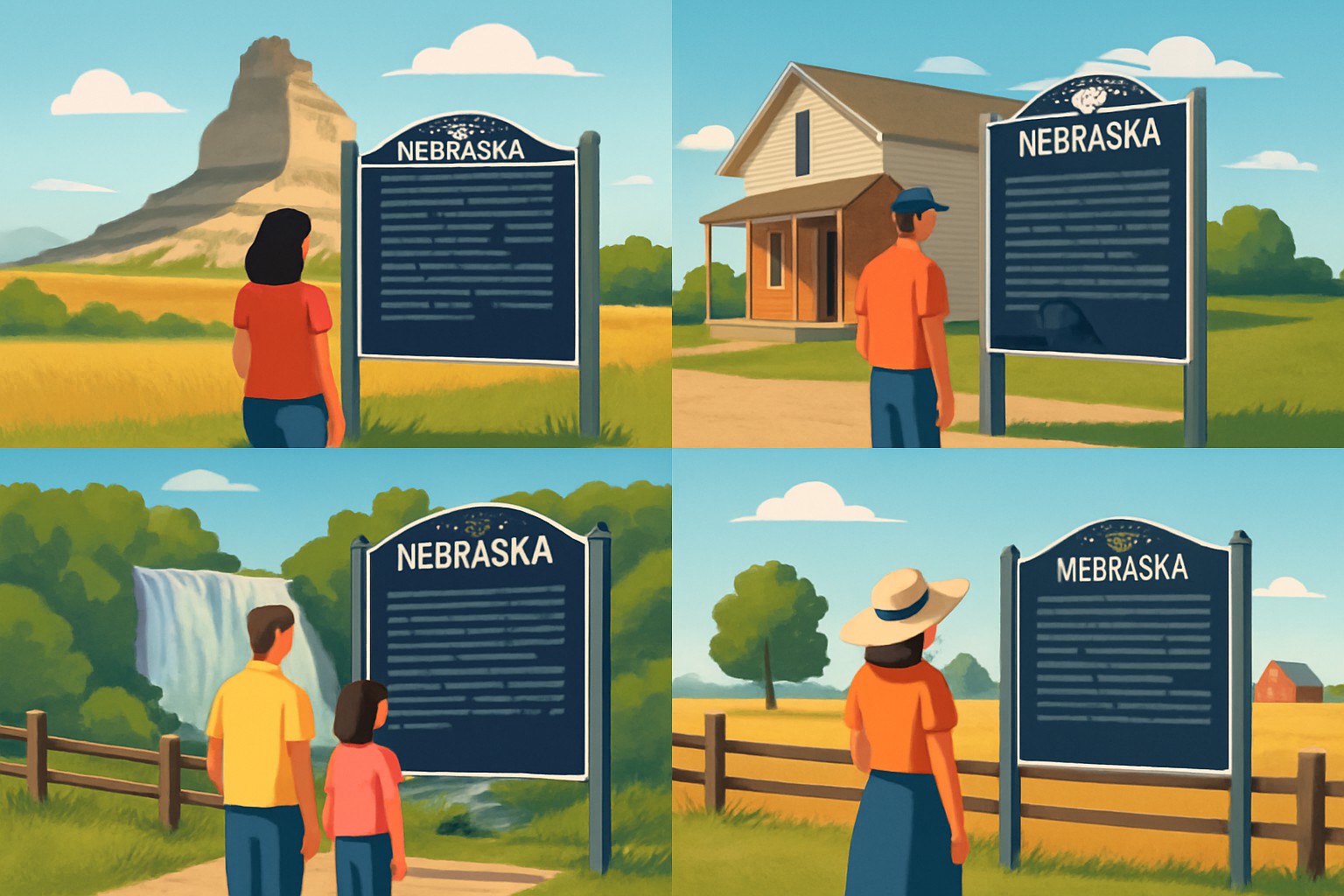Nebraska Historical Markers You Can Visit Today

This article guides you through key historical markers that beautifully showcase Nebraska’s rich and diverse heritage.
- Dive into the top 12 historical markers from the rugged charm of Fort Robinson to the quirky allure of Carhenge and uncover the fascinating stories that bring them to life.
- Discover how to easily track down these markers using official interactive maps, handy apps and guided tours that will make your visit smoother than you expect.
- Pick up practical tips for planning themed trips that keep things safe and accessible and add a meaningful touch to your journey.
- Get the inside scoop on the teamwork behind preserving these markers and find out how you can chip in to support their future — every little bit helps.
Nebraska historical markers play a key role in keeping the state’s rich heritage alive and kicking. They shine a spotlight on notable events, fascinating people and unique places, giving both locals and visitors a chance to really connect with the past.
The Nebraska State Historical Society teams up with local historical groups and municipalities to spearhead the installation and upkeep of historical markers around the state. It’s a real group effort that keeps the markers accurate and easy for individuals to find.
Taking a Closer Look at Nebraska Historical Markers
Historical markers in Nebraska are plaques or signs that honor important events, places and people. They educate the public and preserve memories while being carefully chosen based on specific historical standards.
Nebraska's Historical Markers and Their Development A Journey Worth Remembering
Nebraska’s historical marker program got its start back in the mid-20th century, initially shining a light on pioneer settlements and Native American heritage. These stories set the stage for everything that followed. Over time, the scope naturally broadened to embrace a richer tapestry of history from industrial breakthroughs to key civil rights moments and notable cultural achievements.
Notable Nebraska Historical Markers That Are Definitely Worth a Stop Today
Discover Nebraska’s most significant historical markers scattered across the state, each one unlocking its own unique story and fascinating tidbits.
Fort Robinson Historic Site (Sheridan County): This spot stands as a reminder of a significant US cavalry fort and those pivotal moments tied to the Red Cloud War history you can almost feel in the air.
Pony Express Station (Chadron): Here’s where one of the main relay stations of the legendary Pony Express once buzzed with activity, carrying mail at a breakneck pace across the wild frontier.
Lewis and Clark National Historic Trail Marker (Various Locations): These markers spotlight campsites and landmarks visited by the intrepid Lewis and Clark expedition proof that sometimes, the journey really is the destination.
Homestead National Monument (Gage County): This monument celebrates not just the Homestead Act but also the grit and determination of the early settlers who rolled up their sleeves to make a new life.
Chief Standing Bear Memorial (Omaha): Paying homage to a remarkable Native American leader and his groundbreaking civil rights case a story that still resonates today.
Carhenge (Alliance): A quirky twist where vintage cars stand in for stones at this artistic homage to England’s Stonehenge. It’s history and pop culture rolled into one eye-catching roadside attraction.
The Great Platte River Road (Multiple Markers in Central Nebraska): These markers trace the historic emigrant trails pioneers once followed imagine the hopes and hardships traveled along these routes back in the 19th century.
Oxford Opera House Marker (Fillmore County): Recognizes Nebraska’s first opera house and its early push to bring a little culture and drama to the frontier life.
Old Market Historic District Marker (Omaha): This marker celebrates a historic commercial area cherished for its beautifully preserved 19th-century warehouses and bustling shops where history and everyday life still mingle.
Chimney Rock National Historic Site (Morrill County): Possibly the most famous natural landmark along the Oregon Trail, this rock has been guiding travelers for generations.
Nebraska State Capitol Marker (Lincoln): Delves into the story and architectural significance of Nebraska’s iconic Capitol building standing tall with style and substance.
Indian Mission on the Niobrara River (Knox County): Marks a historic mission site that holds importance for both Native American heritage and missionary history a place where cultures intersected.
It’s best to visit from spring through fall when the weather usually plays nice. Most spots offer visitor centers and restrooms and even local guided tours to keep things interesting. It’s always wise to double-check access to markers beforehand, especially if you’re venturing off the beaten path.

Chimney Rock National Historic Site — a key landmark along historic pioneer trails in Nebraska.
How to Locate and Make the Most of Nebraska Historical Markers for Learning and Enjoyment
Tracking down Nebraska's historical markers is straightforward thanks to a handy mix of resources you can use online and on the ground. Official websites, interactive maps, mobile apps and local tourism centers all pitch in with detailed info that can truly add sparkle to visits.
- The Nebraska State Historical Society website offers a treasure trove with its thorough database and an interactive map that covers every official marker out there.
- State tourism apps come packed with GPS-guided tours and handy suggested routes, perfect for those who want to dive into the historical highlights without a hitch.
- You will find both printed and digital travel guides that neatly group markers by region and theme, making it easier to plan your adventure.
- Local visitor centers typically have brochures on hand and often go the extra mile by sharing well-informed tips on nearby historical gems.
- Community-run historical groups pitch in by maintaining additional markers and throwing educational events that warmly welcome anyone curious enough to join in.
Educators have a great opportunity to weave marker visits into their lessons by organizing field trips that tie into topics like Nebraska history or pioneer life. History buffs appreciate the interpretive texts since they offer valuable context that brings the stories to life. Getting students hands-on with real-world history through these markers sparks critical thinking and builds a much more tangible connection to the past. This helps with retention and fosters a genuine appreciation for heritage.
A Few Things Worth Keeping in Mind
Many historical markers in Nebraska are easily accessible via paved paths but a few tucked away in rural or rugged areas might challenge visitors with mobility issues. It’s wise to plan ahead, slip on sturdy shoes and keep a keen eye when heading out to more off-the-beaten-path spots.
Protecting and Looking Ahead for Nebraska Historical Markers Keeping the Past Alive and Kicking
The work to preserve Nebraska's historical markers is an ongoing labor of love that relies on partnerships among state agencies, non-profits and a passionate crew of community volunteers. Regular upkeep and restoration efforts along with adding new markers reflect a genuine commitment to sharing a lively and inclusive history that speaks to everyone. Clever tools like QR codes have amped up visitor engagement by linking markers to rich digital archives and multimedia.
Local residents and visitors step up by volunteering for maintenance programs and reporting any damage or vandalism they spot. They also get involved in educational outreach events. Lending a hand to local museums and historical societies not only keeps marker projects afloat but sparks a deeper appreciation for Nebraska’s rich heritage.
"Nebraska's historical markers are more than just signs on the roadside; they’re like little time capsules that tie our past generations to the here and now. They help keep our shared history alive and kicking. Taking care of these markers is not just about preservation—it’s about making sure that future Nebraskans and visitors alike can keep learning from and appreciating the rich tapestry of our collective story." — Sarah Thompson, Nebraska Historical Society Director
Plan Your Visit with Practical Tips and Sample Itineraries to Make the Most of Your Trip
Planning a trip to Nebraska's historical markers often works best when you pick themed itineraries that zero in on specific historical topics or regions. These carefully crafted routes provide a neat and engaging way to dive into Nebraska's rich heritage.
- Follow the Pioneer Trails itinerary to catch markers along the Oregon, California and Mormon Trails that bring to life the brave journeys of early settlers who blazed the way.
- Dive into Native American history by checking out markers linked to tribal heritage, treaties and influential leaders whose stories are often overlooked but worth hearing.
- Stop by Civil War sites that shine a light on Nebraska’s military role and pay tribute to veterans with memorials that quietly speak volumes.
- Celebrate notable Nebraskans with markers that tip a hat to key state figures in politics, arts and innovation—people who left their mark in big and small ways.
- Take a tour of architectural landmarks that have earned their stripes for historical and design value. These include historic courthouses and public buildings that stand as proud reminders of the past.
You can easily lean on personal vehicles or hop on regional tour buses that often team up with local guides for getting around. Nebraska offers a good mix of lodging options ranging from charming bed and breakfasts in quaint small towns to comfortable hotels in bigger cities like Omaha and Lincoln. Many of the nebraska historical markers pop up near inviting local spots like museums, parks and cultural centers—adding extra flavor and context to your visit.





